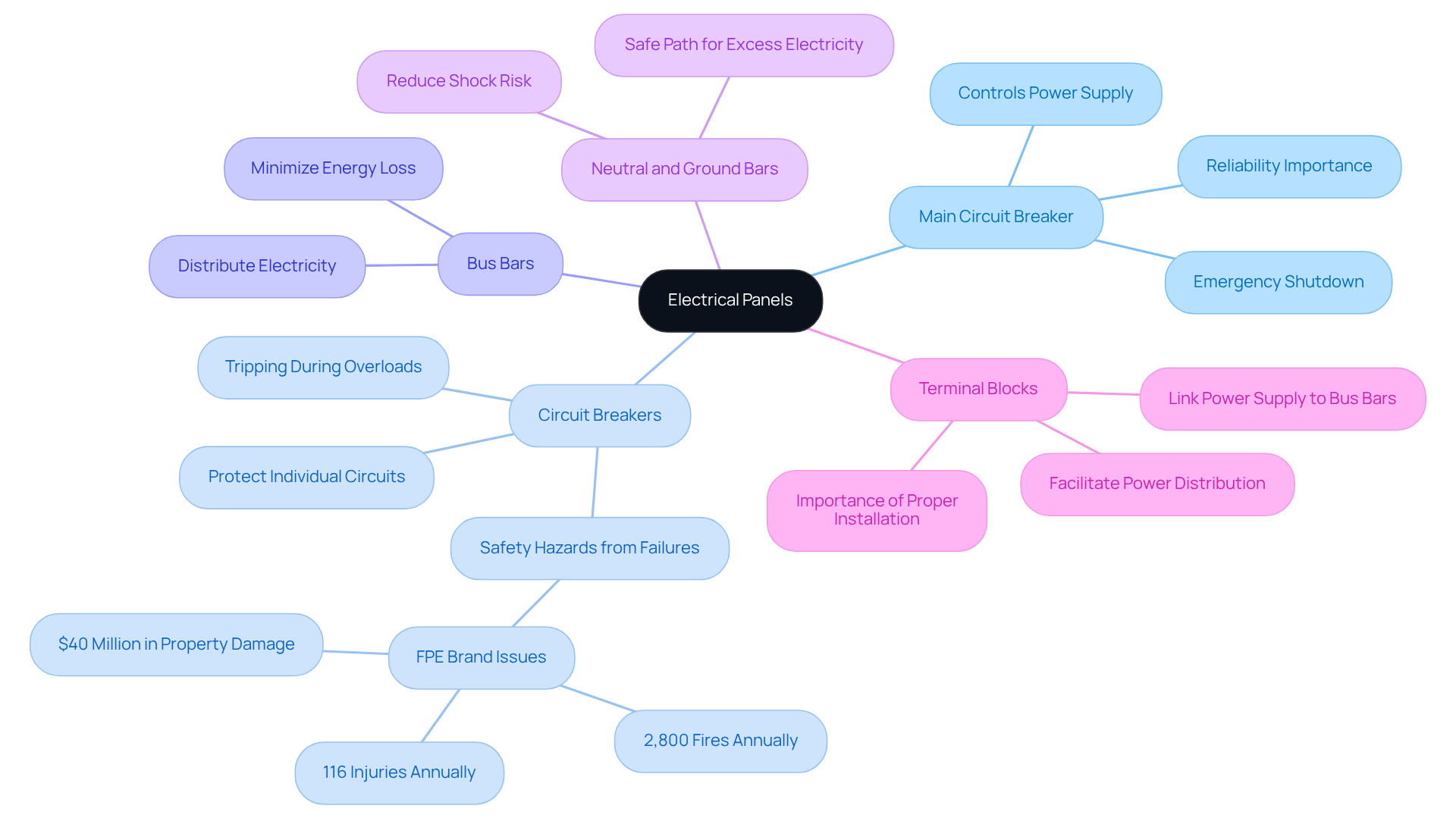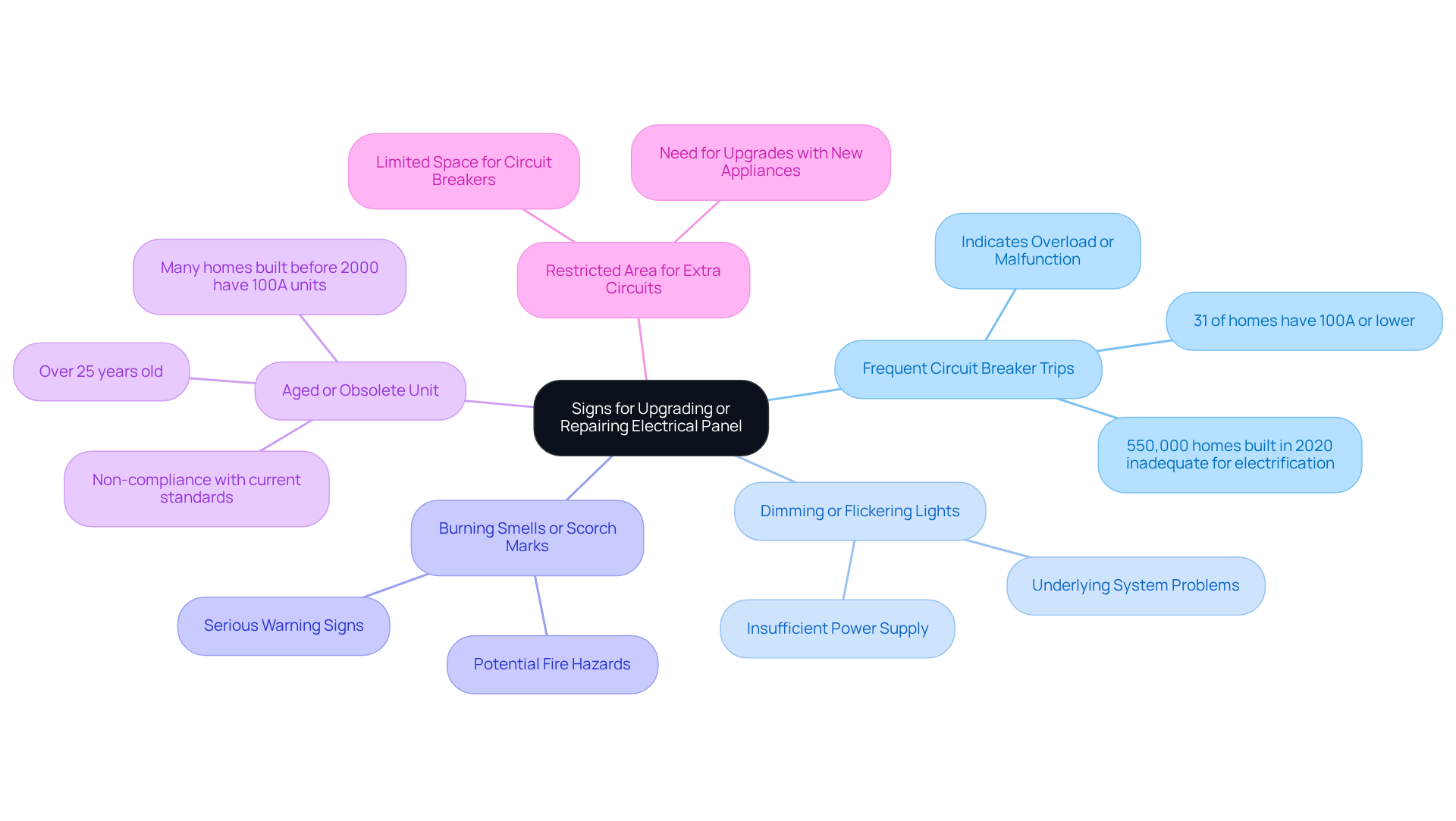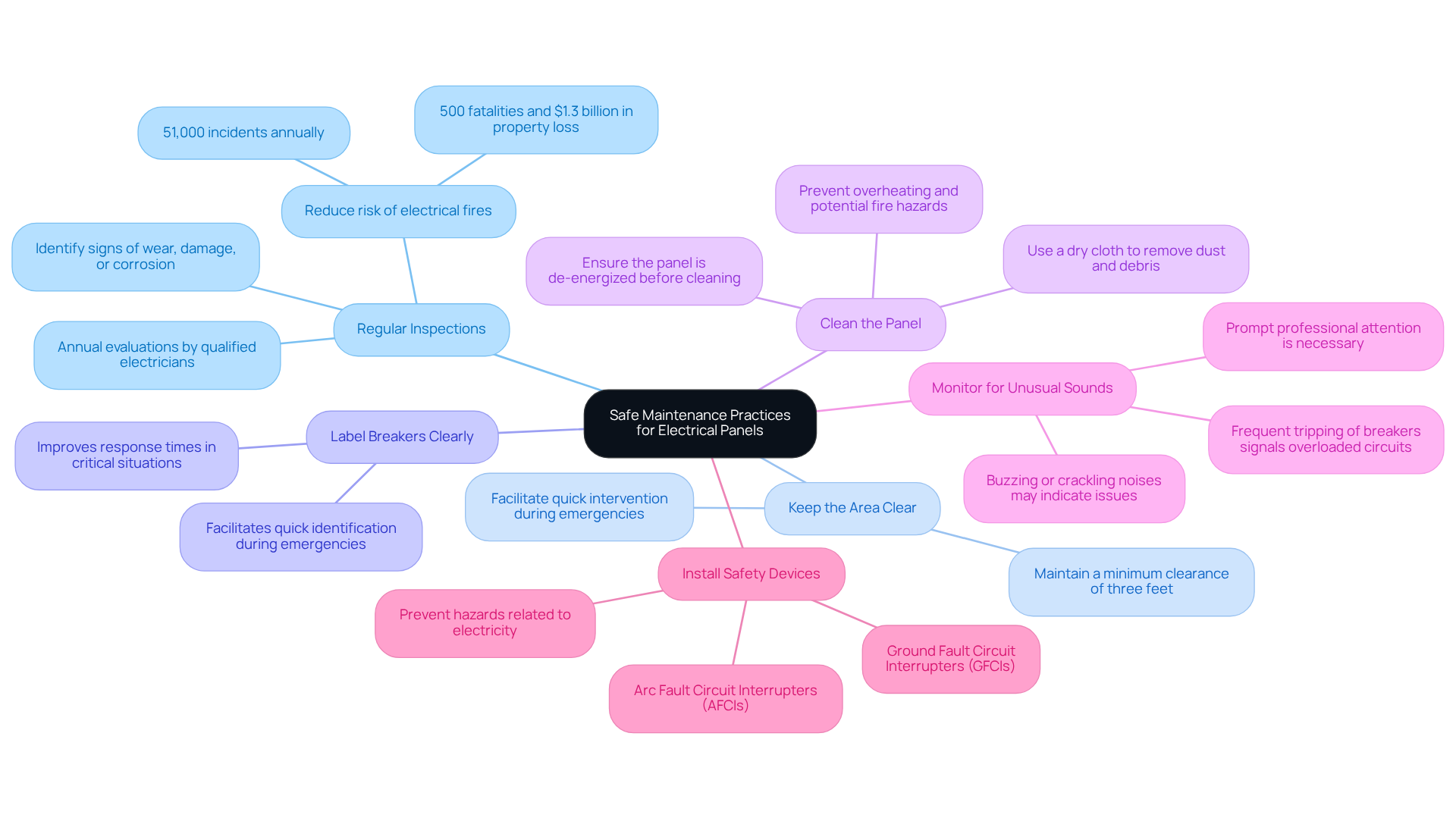Overview
Electricity panels, often referred to as breaker boxes, play a vital role in ensuring the safe management and distribution of electrical power within our homes. We understand that concerns about overloads and potential hazards can weigh heavily on your mind. This article highlights the critical importance of maintaining modern electrical systems, as it not only helps prevent risks such as electrical fires but also promotes efficient energy management.
Regular inspections, timely upgrades, and adherence to safety practices are essential steps we can take together to safeguard our homes and loved ones. By prioritizing these measures, we can create a safer environment and protect against unforeseen dangers.
Introduction
Understanding the critical role of electricity panels is essential for homeowners who prioritize safety and efficiency in their living spaces. We understand that these panels serve as the nerve center of a home’s electrical system, managing power distribution and protecting against potential hazards. However, it’s common for many homeowners to be unaware of the signs indicating that their electrical panels require attention or the maintenance practices that can enhance their longevity.
What steps can we take together to ensure these vital systems remain reliable and safe, preventing costly damages and dangerous situations? Let’s explore how we can work towards a safer, more efficient home.
Define Electrical Panels and Their Importance
We understand that as homeowners, your safety and the reliability of your home’s power system are paramount concerns. Breaker boxes, often referred to as service units, play a crucial role in your home’s power infrastructure. They serve as the central hub for distributing electricity, connecting the external power supply to your internal circuits. Their main function is to manage power loads safely, protecting against overloads and ensuring efficient energy delivery to your various appliances and devices.
It’s concerning to note that data indicate power-related fires represent around 51,000 occurrences each year in the U.S., with malfunctioning circuits notably contributing to these hazards. Moreover, over 1,400 injuries result from fire incidents annually, emphasizing the safety issues linked to outdated systems. If your home is fitted with obsolete devices, particularly those constructed from the 1950s to the 1980s, you may be facing an elevated risk. Approximately 1 in 4 Federal Pacific Electric (FPE) breakers might not trip, raising the chances of fire hazards by 20%.
The financial consequences are also considerable; fires caused by electricity result in roughly $1.3 billion in direct property damage each year. The significance of maintaining cannot be overstated, as it directly affects your safety and the dependability of your residence’s power system. Without it, homeowners risk power outages, potential fires, and damage to their devices.
Investing in advanced electrical systems, such as electricity panels, not only enhances safety but also improves energy management, ensuring that your home can meet the demands of . Together, we can work towards creating a safer and more efficient living environment for you and your family.
Explain How Electrical Panels Operate
We understand that managing energy bills can be a source of concern for many homeowners. Electrical units serve as the central hub for electricity distribution in your home, receiving power from the utility company through a service line. Once the electricity reaches the distribution board, it is directed to various circuits through circuit protection devices. Each circuit breaker is thoughtfully designed to protect different areas of your home, like lighting or appliances, by interrupting the flow of electricity during overloads or faults. This protective mechanism not only enhances safety but also empowers you to manage effectively.
It’s common to feel overwhelmed by energy costs, but contemporary electricity panels can seamlessly connect with solar energy systems, allowing you to harness renewable energy in a meaningful way. Imagine significantly lowering your idle power consumption, which accounts for 5% to 10% of home electricity usage—this can greatly [enhance your energy efficiency](https://gopowercoreinc.com/solar-battery-storage-insights/10-benefits-of-solar-powered-backup-generators-for-residential-use/). Together, we can explore how intelligent displays can support you in this journey.
Specialist views emphasize the essential function of circuit interrupters in preserving system integrity and addressing energy requirements, especially as homes increasingly embrace modern technologies such as electricity panels and electric vehicle chargers alongside solar setups. Let’s work towards a more sustainable future, where you feel empowered and supported in .
Identify Key Components of Electrical Panels
Understanding the components of electricity panels is vital for homeowners who care about their . The Main Circuit Breaker serves as the primary switch that controls the power supply to the entire panel, enabling a complete shutdown of electricity to your home during emergencies. Its reliability is crucial; failures in circuit devices can lead to significant safety hazards, and we want to ensure you feel secure in your environment.
Circuit Breakers are smaller switches that protect individual circuits by tripping during overloads, effectively preventing potential hazards like electrical fires. Did you know that certain brands of circuit devices, such as FPE models, are linked to around 2,800 fires each year and 116 injuries annually? This underscores the importance of choosing dependable products that safeguard your home.
Bus Bars are conductive metal strips that distribute electricity from the main switch to the circuit protectors. They play a vital role in ensuring efficient power distribution and minimizing energy loss, which can help lower your energy bills.
Neutral and Ground Bars provide a safe path for excess electricity to ground, significantly reducing the risk of shock and enhancing overall safety in your power system. It’s common to feel anxious about electrical safety, but understanding these components can help alleviate those concerns.
Terminal Blocks link the incoming power supply to the bus bars and circuit switches, facilitating efficient power distribution. Proper installation and maintenance of terminal blocks are essential for optimal performance and safety, giving you peace of mind.
Grasping these elements is essential for homeowners aiming to enhance their power systems. By upgrading to higher-quality circuit interrupters and ensuring proper bus bar functionality, you can greatly improve safety and efficiency in your residential power systems, particularly with the use of electricity panels. Electricians emphasize that investing in dependable circuit protection is crucial for avoiding hazards and ensuring long-term safety in your home. Together, we can work towards a safer and more efficient electrical system that meets your needs.
Recognize Signs for Upgrading or Repairing Your Electrical Panel
As homeowners, it’s important to be vigilant about the signs that may indicate your electricity panels need upgrading or repair. We understand that safety and efficiency are top concerns, and recognizing these signs can help ensure your home remains a secure and functional space.
- Frequent Circuit Breaker Trips: If your breakers are tripping often, it may suggest that the panel is overloaded or malfunctioning. Did you know that around 31% of homes have power systems rated at 100 amperes or lower? This can limit your ability to integrate new electric appliances without significant enhancements. Furthermore, approximately 550,000 residences built in 2020 alone have electric systems that won’t allow for complete home electrification, underscoring the urgency of this issue.
- Dimming or Flickering Lights: This can indicate an insufficient power supply or underlying problems within the system, often revealing that the power network is struggling to meet current demands.
- Burning Smells or Scorch Marks: Any unusual odors or visible damage around the surface are serious warning signs that should be addressed immediately, as they can indicate potential fire hazards.
- Aged or Obsolete Unit: If your unit is over 25 years old, it may not comply with current wiring regulations or safety standards. Many homes built before 2000 might still have 100A units that fall short of contemporary power requirements.
- Restricted Area for Extra Circuits: If you plan to add more devices or appliances, a small unit may require an upgrade. Homes with outdated systems often lack adequate space for the necessary circuit breakers for modern setups.
By identifying these signs, you can take prompt action, ensuring safety and functionality in your home’s power system. Upgrading your electrical system by installing electricity panels can significantly , reducing the risk of electrical fires and improving overall power distribution. The typical cost to upgrade to a 200A unit ranges from $1,300 to $3,000, making it a valuable investment for homeowners looking to address their growing energy needs. Additionally, you might consider smart displays and home energy management systems (HEMS) as alternatives to upgrading, which can help manage energy loads and prevent system overload. As one specialist observed, ‘By updating with a 200A system and service, homeowners will be well-equipped to address their increasing energy demands.’ Together, we can ensure your home is safe and prepared for the future.
Implement Safe Maintenance Practices for Electrical Panels
To ensure the safe maintenance of electrical panels, we understand how important it is for homeowners to adhere to the following best practices:
- Regular Inspections: Scheduling annual inspections with a qualified electrician is essential to identify signs of wear, damage, or corrosion. Routine evaluations can significantly reduce the risk of fires caused by electricity, which occur about 51,000 times each year, leading to 500 fatalities and $1.3 billion in property loss. It’s particularly concerning that almost half of the fatalities from household fires originate in typical living areas, underscoring the need for vigilance in these spaces.
- Keep the Area Clear: Maintaining a clutter-free space around the electrical unit, ensuring a minimum clearance of three feet, is vital. This accessibility allows for quick intervention during emergencies, providing peace of mind.
- Label Breakers Clearly: Properly labeling breakers facilitates quick identification of circuits during emergencies or maintenance, enhancing safety and efficiency. As highlighted in case studies, accurate labeling can significantly improve response times in critical situations, which is something we all want in times of need.
- Clean the Panel: Using a dry cloth to remove dust and debris is important, but remember to ensure the panel is de-energized before cleaning. Regular cleaning helps prevent overheating and potential fire hazards, contributing to a safer home environment.
- Monitor for Unusual Sounds: Staying alert for buzzing or crackling noises is crucial, as these may indicate underlying wiring issues that require immediate professional attention. Frequent tripping of breakers can also signal overloaded circuits or faulty breakers, which necessitates a licensed electrician’s intervention. It’s common to feel concerned when these issues arise, but addressing them promptly can prevent larger problems.
- Install Safety Devices: Consider installing Ground Fault Circuit Interrupters (GFCIs) and Arc Fault Circuit Interrupters (AFCIs). These essential devices are designed to prevent hazards related to electricity, significantly improving the safety of your power system.
By adopting these practices together, we can greatly improve the safety and dependability of our power systems, ultimately decreasing the chances of incidents. As Rick Grohman, a leading electrical contractor, states, “One of the key components in maintaining a safe and efficient electrical system is regular maintenance of your electricity panels.” Let’s work towards creating a safer environment for ourselves and our loved ones.
Conclusion
Understanding the function and maintenance of electrical panels is essential for ensuring the safety and efficiency of your home’s power system. These panels serve as the backbone of electrical distribution, managing power loads and protecting against potential hazards. Their significance cannot be overstated, as they play a crucial role in safeguarding your home from electrical fires and ensuring reliable energy delivery to modern appliances.
We understand that many homeowners may feel overwhelmed by the complexities of electrical systems. Throughout this article, we have shared key insights regarding the operation, components, and maintenance of electrical panels. From the importance of upgrading outdated systems to recognizing signs that indicate a need for repair, you are now equipped with the knowledge to enhance your electrical safety. Regular inspections, proper labeling, and the installation of safety devices are just a few of the proactive measures that can significantly reduce risks associated with electrical systems.
Ultimately, embracing the maintenance and understanding of electrical panels fosters a safer living environment. We encourage you to prioritize your electrical safety by investing in modern systems and adhering to best practices. By doing so, the likelihood of electrical incidents can be minimized, paving the way for a more secure and efficient home. Taking these steps not only protects your property but also ensures peace of mind for your family living in today’s increasingly electrified world.







